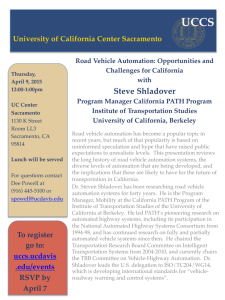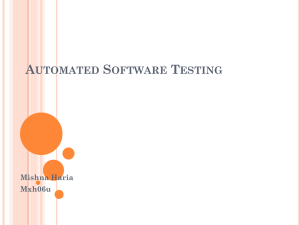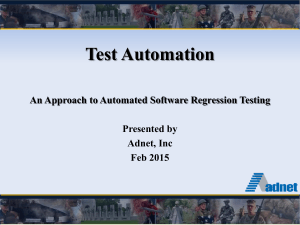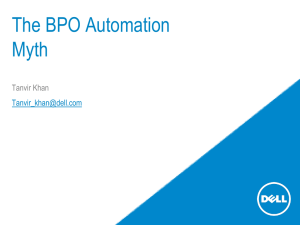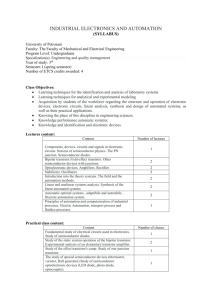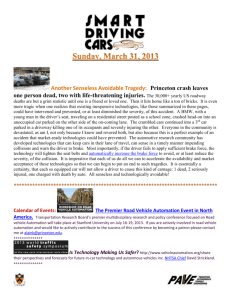Manufacturing Automation - Deciding If It Makes Sense
advertisement
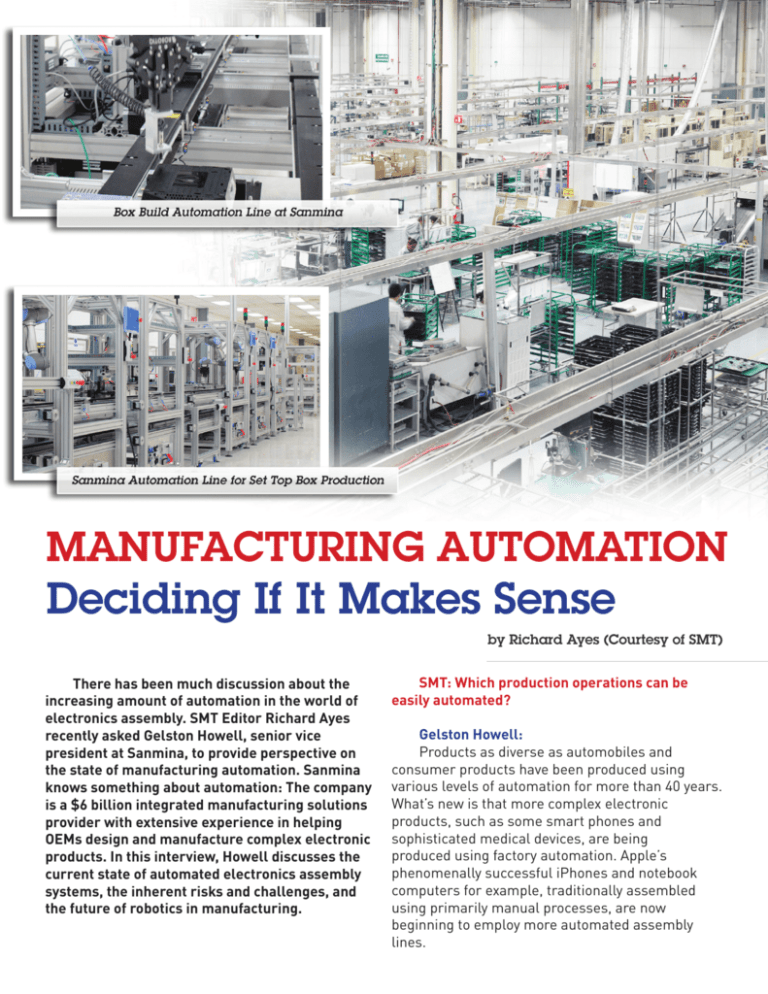
MANUFACTURING AUTOMATION Deciding If It Makes Sense by Richard Ayes (Courtesy of SMT) There has been much discussion about the increasing amount of automation in the world of electronics assembly. SMT Editor Richard Ayes recently asked Gelston Howell, senior vice president at Sanmina, to provide perspective on the state of manufacturing automation. Sanmina knows something about automation: The company is a $6 billion integrated manufacturing solutions provider with extensive experience in helping OEMs design and manufacture complex electronic products. In this interview, Howell discusses the current state of automated electronics assembly systems, the inherent risks and challenges, and the future of robotics in manufacturing. SMT: Which production operations can be easily automated? Gelston Howell: Products as diverse as automobiles and consumer products have been produced using various levels of automation for more than 40 years. What’s new is that more complex electronic products, such as some smart phones and sophisticated medical devices, are being produced using factory automation. Apple’s phenomenally successful iPhones and notebook computers for example, traditionally assembled using primarily manual processes, are now beginning to employ more automated assembly lines. The medical device industry has been going through a similar transition, with disposable medical device manufacturers designing machines to automate complex and precise operations. Of course, driving down costs is a priority, but the evolution is partly due to the desire to improve quality and reduce costs for products with increasing complexity. For example, until recently a respiratory inhaler would have consisted of only mechanical parts, but now electronics are embedded in the product, improving functionality. As a result of the increased complexity, automated lines are being developed to manage costs and produce devices with extremely high quality. Industrial sectors, such as clean technology and automotive electronics, are also exploring how automation can help them get products to market at lower costs and with better quality. Regardless of the industry segment, applying automation for products manufactured in high volumes can result in substantially reduced costs. • Labor costs (total work content of operations, techs and engineers) • Cost of capital equipment • Running costs of equipment (maintenance, spare parts, etc.) • Equipment flexibility and reusability • Life cycle remaining after installation and release of equipment • Raw materials in facilities and reduced inventory turns SMT: What factors determine whether automated production makes sense? Howell: Automated assembly can be used to produce new products or replace an existing manual manufacturing process, but not all products will benefit from automation. When evaluating which products are a good fit for automation, there are numerous variables, including financial analysis, time to market, product design and operations considerations. SMT: How quick is the return on investment, and what else should be considered? Howell: A $6 million investment in capital equipment, designed to output over five million units per annum, with an ultimate savings of $1 per unit in reduced labor costs, would offer a return on investment (ROI) in less than 15 months. When comparing the ROI on manual vs. automated assembly, here are some other factors to consider: • Time available before start of production • Number of product variants • Work content per assembly or subassembly • Advantages of repeatability and process control • Manual handling of parts and impact on product quality Part of an Automation Line for Medical Device Manufacturing at Sanmina. SMT: What risks and challenges must be considered when a decision has been finalized to automate certain assembly processes? Howell: To begin analyzing the feasibility of an automation project, companies need to consider production volumes, labor content and the time needed to develop automated production equipment. Typically, annual volume targets should be in the hundreds of thousands or millions of units because of the financial investment required to set up an automated line. The analysis includes the takt time (time per production step), which is the target rate of output from the manufacturing system. Depending on planned shift patterns, for an annual output of five million units, a target takt time of six seconds may be required (or one unit produced every six seconds). The cumulative process time, requiring the presence of a person, drives the direct labor cost for a manual operation; in contrast, a fully automated equivalent operation has a reduced or eliminated direct labor cost. Also, part-tolerance stack-up analysis and the inclusion of design features for ease of component assembly serve to “derisk” the implementation of automated assembly solutions. Manual assembly processes are much more forgiving of component tolerance issues. For example, plastic components that are slightly warped pose no problems for manual assembly. However, these same components may not be usable with an automated component feeder or with pick and place equipment. The worst-case scenario would be damage to the assembly equipment due to a part collision. SMT: Does your company have actual experiences regarding automating your production/assembly processes? Howell: Yes, we have implemented many hands-off, fully automated system assembly lines over the past eight years. We work with OEMs and product designers along with several automation equipment providers to create the most costeffective and reliable automation solutions possible. Due to the complexity of manufacturing platforms and industry best-practice requirements, automation solution providers tend to specialize in discrete market segments, such as consumer, medical or automotive. These providers then will typically have a core competency or be able to demonstrate greater experience in an area such as the following: • Challenging operating environments such as Class 8 clean rooms • Niche skills such as plastics, odd-form mechatronic assembly, electronic testing, and final packaging • Integration of advanced technologies such as vision systems, precision fasteners, dispensing and curing • Laser systems suitable for high throughput and precise material handling, welding, cutting and marking products, especially for the assembly of miniature components, within the medical device and pharmaceutical industries SMT: Why does implementing an automated assembly line take so much time? Howell: Automation requires custom tooling, additional design features in certain components and often some custom equipment—one size does not fit all. It can take from six months to two years to develop, implement and validate complex automated processes and equipment for system assembly and test. This investment can pay off. Once running, products can be produced at lower costs, and often the same automated production equipment can be used for the next generation of products. Automation Line at Sanmina. SMT: Why don’t companies jump straight into automated assembly? Howell: Automation can and does save money, but there are risks involved and financial and time commitments required to make automation successful. And certainly, not all products benefit from manufacturing automation. Basic considerations include both a time to market and financial analysis. That is, is there enough time to implement automation and will it pay off based on product complexity, volumes, the availability of suitable automation cells (that can be customized) and other factors? Another factor for successful assembly automation is designing the product for automation. Involving equipment builders in the early design phase of a new product offers the greatest opportunity and flexibility to include design features in the product and components so that assembly automation can be kept as simple as possible. This investment in time and effort will pay off when closing in on the product launch date. Products that have been designed in accordance with DFAA (design for automated assembly) and DFT (design for testability) principles enable the engineering team to identify and eliminate unforeseen issues, which would later result in efficiency or quality issues during the volume manufacturing phase. SMT: What are some of the pros and cons of robotics replacing human workers in an assembly line? Howell: Images of futuristic-looking robots rapidly and efficiently assembling products permeate modern advertising. And, the reality is that automated assembly can save money and improve quality for a growing number of product types. This is an area that will continue to advance. On the other hand, there are a significant number of complex, high-mix, lowvolume products such as large format printers, industrial and complex medical equipment where the lower volumes and high complexity do not justify a fully automated solution. SMT Gelston Howell Senior Vice President of Marketing Sanmina Corporation
